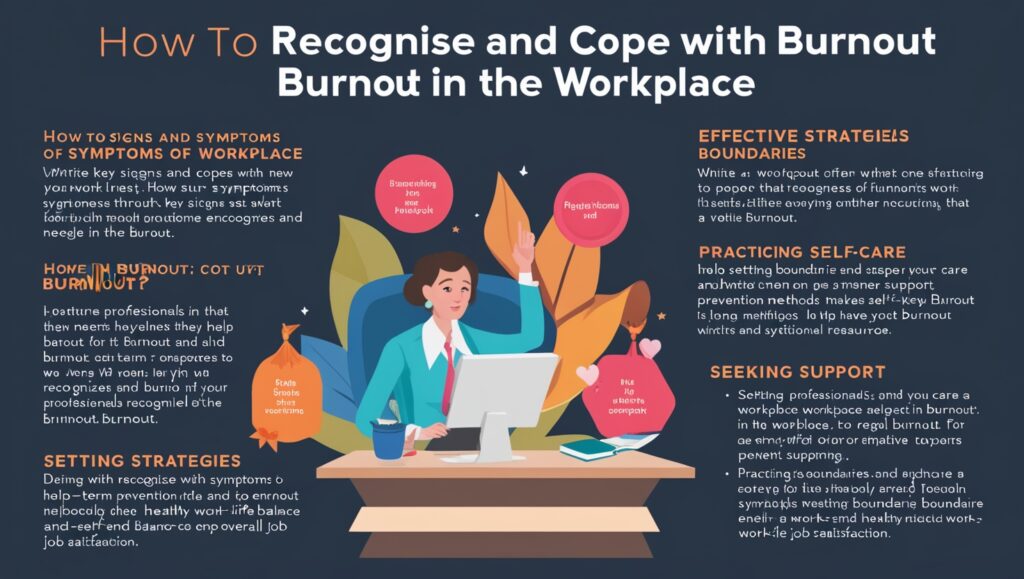Recognizing and Coping with Burnout in the Workplace
Burnout has become a widespread concern in the modern workplace, affecting millions of professionals globally. This silent stressor, if left unchecked, can lead to significant mental, emotional, and physical repercussions. Recognizing and addressing burnout is essential for personal well-being and sustained professional productivity. In this blog, we’ll explore the signs of burnout, factors that contribute to it, and effective coping strategies to help navigate and mitigate its impact.
What is Burnout?
Burnout is a state of chronic physical and emotional exhaustion, typically resulting from prolonged stress or overwork. It goes beyond the occasional feeling of tiredness or stress; it’s an all-consuming condition that can sap one’s energy and motivation, impacting work performance and quality of life. The World Health Organization (WHO) classifies burnout as an “occupational phenomenon,” characterized by three main dimensions:
- Exhaustion – A deep feeling of fatigue that doesn’t subside with rest.
- Cynicism – A growing detachment from work or feeling negative about tasks and colleagues.
- Ineffectiveness – Reduced professional efficacy, making even simple tasks feel daunting.
Recognizing the Signs of Burnout
Understanding and recognizing the signs of burnout is the first step toward managing it effectively. The following are common indicators:
- Physical Symptoms: Persistent headaches, digestive problems, frequent illnesses due to weakened immunity, and trouble sleeping.
- Emotional Signs: Feeling detached, hopeless, irritable, or impatient. A pervasive sense of failure and self-doubt may arise.
- Behavioral Changes: Withdrawing from responsibilities, procrastination, isolation from colleagues, and reduced performance at work.
- Cognitive Impairment: Difficulty concentrating, forgetfulness, and reduced ability to make decisions or solve problems.
Factors Contributing to Workplace Burnout
Several factors can contribute to burnout, including:
- Work Overload: Excessive workload or unmanageable job demands can lead to continuous stress, ultimately causing burnout.
- Lack of Control: Having little control over one’s schedule, workload, or tasks can foster feelings of helplessness.
- Insufficient Support: Working in an environment without strong support from managers or colleagues can exacerbate stress.
- Unclear Job Expectations: Uncertainty about job roles or expectations can lead to anxiety and stress.
- Work-Life Imbalance: Spending more time at work and less time on personal life, relationships, and hobbies can diminish overall well-being.
Coping Strategies for Burnout
If you recognize the signs of burnout in yourself or others, it’s crucial to take proactive steps. Here are some coping strategies:
1. Acknowledge the Issue
The first step in dealing with burnout is recognizing that it exists. Denying or ignoring it can worsen the condition. Be honest with yourself about how you’re feeling and take the necessary steps to address it.
2. Communicate Openly
Talk to your supervisor or HR department about how you’re feeling. An honest conversation can help in finding solutions, such as delegating tasks or adjusting workloads. Many employers are willing to support employees through difficult times.
3. Prioritize Self-Care
Focus on activities that recharge you:
- Exercise: Regular physical activity, even if it’s just a 15-minute walk, can boost your mood and energy levels.
- Sleep: Ensure you’re getting adequate rest. Lack of sleep can exacerbate feelings of exhaustion and stress.
- Healthy Eating: Nutrient-rich foods support your body’s ability to cope with stress
4. Set Boundaries
Learn to say no when your workload becomes overwhelming. Set boundaries between work and personal life to avoid the trap of working late hours consistently. Use technology wisely by disconnecting from work emails or notifications during non-working hours.
5. Engage in Mindfulness and Relaxation
Mindfulness practices like meditation, deep-breathing exercises, or yoga can help you stay grounded and manage stress effectively. Taking short, mindful breaks during the day can refresh your mind and improve focus.
6. Seek Support
Don’t hesitate to seek support from friends, family, or professional counselors. External perspectives can provide insight and help you feel less isolated.
7. Reevaluate Your Goals
Take some time to assess what you want out of your career and personal life. Are you working in alignment with your values and goals? If not, it might be time to consider a change in job roles, responsibilities, or even careers.
Long-term Prevention Strategies
For sustainable relief, consider long-term changes that promote a healthier work-life balance:
- Time Management: Break large projects into manageable tasks. Use time management tools to organize your schedule.
- Develop a Support Network: Build strong connections with colleagues and professionals who can relate to your experiences and offer mutual support.
- Continuous Learning: Stay informed about best practices for stress management and personal productivity through workshops or courses.
- Employer Initiatives: Advocate for workplace policies that promote mental health, such as wellness programs or flexible working conditions.
Final Thoughts
Burnout is a serious issue that can undermine not only job satisfaction but also overall health and happiness. Recognizing the warning signs and implementing effective coping strategies is vital for anyone experiencing it. Whether you’re an employee feeling the strain or a manager looking to support your team, proactive measures can create a healthier, more balanced work environment.
Addressing burnout requires a combination of personal reflection, support, and systemic change. By adopting these strategies and promoting a culture that values well-being, individuals and organizations alike can work toward a future that prioritizes health and productivity in harmony.

